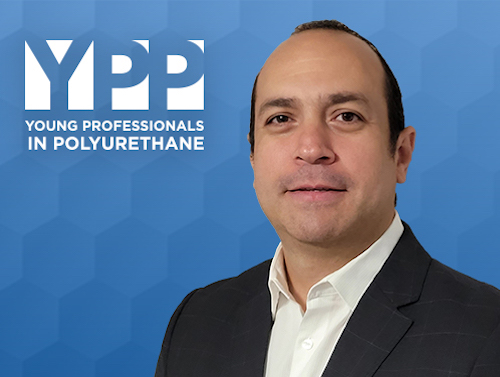young professionals

A Young Polyurethane Professional Works to Create Wood Composites of the Future
Name: Gustavo Leon
Age: 43
Title: Technical Specialist
Company: BASF
While completing his degree in chemistry at a master’s program, Gustavo Leon first learned about polyurethane production and polyurethane’s presence in everyday products. Raised and educated in Venezuela, Gustavo’s love of chemistry eventually led him to seek a career in the United States. Here, he could find more professional opportunities and a better way of life.
Soon after finishing his master’s degree, Gustavo joined BASF in the U.S. He later became a part of the Wood Binder Adhesives team there, where he gained further knowledge about the role of polyurethane resins in the process of creating wood composites.
Frequent readers of this blog know that polyurethane is a common material in commercial and residential construction. When used in the production of wood composites, a polymeric diphenylmethane diisocyanate — or PMDI — resin acts as a binding agent, holding wood particles together. A wood composite is most often molded or compressed into a flat sheet and is used to create finishes, flooring and furniture.
Creating Safer Wood Composites
Today, Gustavo serves as a technical specialist for BASF, working hand-in-hand with customers, supporting them and guiding them through the purchase and safe use of PMDI applications for wood composites.
“Buildings and furniture that feature wood composites are only growing more prevalent,” Gustavo says. “There’s a big responsibility to help manufacturers make informed choices when it comes to the PMDI binders they use in their wood composites to ensure proper indoor air quality. The work we do helps thousands of offices and homes stay healthy and safe.”
In addition to his sales and support role, Gustavo’s duties also involve helping conduct customer product trials and managing lab work to improve upon the overall performance of PMDIs in the wood composite industry.
A World Increasingly Reliant on Polyurethane
From the automotive industry to furniture design and even in farming and construction, polyurethane plays a part in many aspects of everyday products. It’s a role Gustavo believes will grow in the coming years.
“With the world’s population increasing, we are putting a strain on resources and therefore need better-performing, longer-lasting products for everyone,” Gustavo says. “Polyurethane has a prominent role to play in helping us achieve better performance, durability and efficiency in the life of many household goods.”
Gustavo’s work in wood composites is a good example of using polyurethane to help stretch natural resources. Wood composites can be made from wood waste materials that might otherwise be thrown out at the sawmill and wood from smaller trees can also be used in its production.
Gustavo believes that in addition to helping increase the shelf-life of products now and into the future, the polyurethane industry will continue to find new and innovative ways to close the loop on the circular economy.
“Polyurethane is helping to stretch resources like in the case of wood composites,” Gustavo says. “However, research and development are also concentrating on finding new ways of helping polyurethane become more recyclable and easier to reprocess into new and different products.”
A Career at the Forefront of Innovation
As part of an overall push toward creating greater sustainability, Gustavo says he is setting his career sights on advancing the role of PMDIs in the use of wood composites in the coming years. Through his team’s research, BASF is improving the efficiency of the PMDI resins it is creating, yielding more durable wood composites and creating an overall reduction of waste.
“The most rewarding part of my job is the big smile I receive from customers after I’ve helped them improve their processes to make a more durable product,” Gustavo says. “When we use less wood to create a more durable product, it’s a win for everyone in the supply chain, for the end customer, and for the Earth.”
Advice for Younger Polyurethane Professionals
When it comes to dispensing advice to a generation of up-and-coming polyurethane professionals, Gustavo is a firm believer that your past and the mistakes you make along the way help shape you into the person you are meant to be.
“I have no regrets about the direction of my career or the decisions I made along the way,” he says. “All of those things led me to where I am meant to be. The only thing I might change is I wish I had a little more self-awareness earlier and had studied a wider range of subjects in school.”
His conviction to leave history well enough alone may have something to do with an event in his life few of his colleagues know about, but which may have given him a unique perspective about his work in wood composites.
A Deadly Earthquake Strikes Chile
“In 2010, I was in Concepcion, Chile, when an 8.8 magnitude earthquake struck and destroyed the area,” Gustavo says. “Most people do not know that I survived one of the deadliest earthquakes ever. It was not easy living through that experience.”
The shaking caused by the quake lasted a full three minutes, a lifetime for an earthquake, and caused an estimated $66.7 million of damage to the region. After his apartment was condemned, Gustavo slept in a hotel’s lobby until a charitable coworker picked him up and drove him to his home.
“My boss actually rescued me from the hotel,” Gustavo said. “He later told me after he found out my apartment building was condemned, he and his son walked to every hotel in the city trying to find me.”
Wood composites, like those that Gustavo helps to create, have increasingly been used for the design of homes and multi-story buildings in earthquake-prone areas. The lightweight material can absorb the inertial seismic forces, which, proportional to weight, can perform better than a concrete or steel-beamed structure.
“This experience made me more grateful and more mindful about the work that I do,” Gustavo says. “It made me hold to faith and appreciate everything around me. Meditation has become a part of my life, and I say thank you even when things are not going as well as expected.”
Through smart engineering and use of materials, Gustavo’s work in wood composites may be helping to improve life for thousands of people, living in regions of the world affected by earthquakes. As a result, he brings a unique perspective to his work and a certain optimism about what the future holds.
“You can cry or feel sad, but you always need to keep going to get ahead,” Gustavo says. “It’s more important to move forward to ensure the future we’re creating for ourselves and the generations yet-to-come is a bright one.”



















